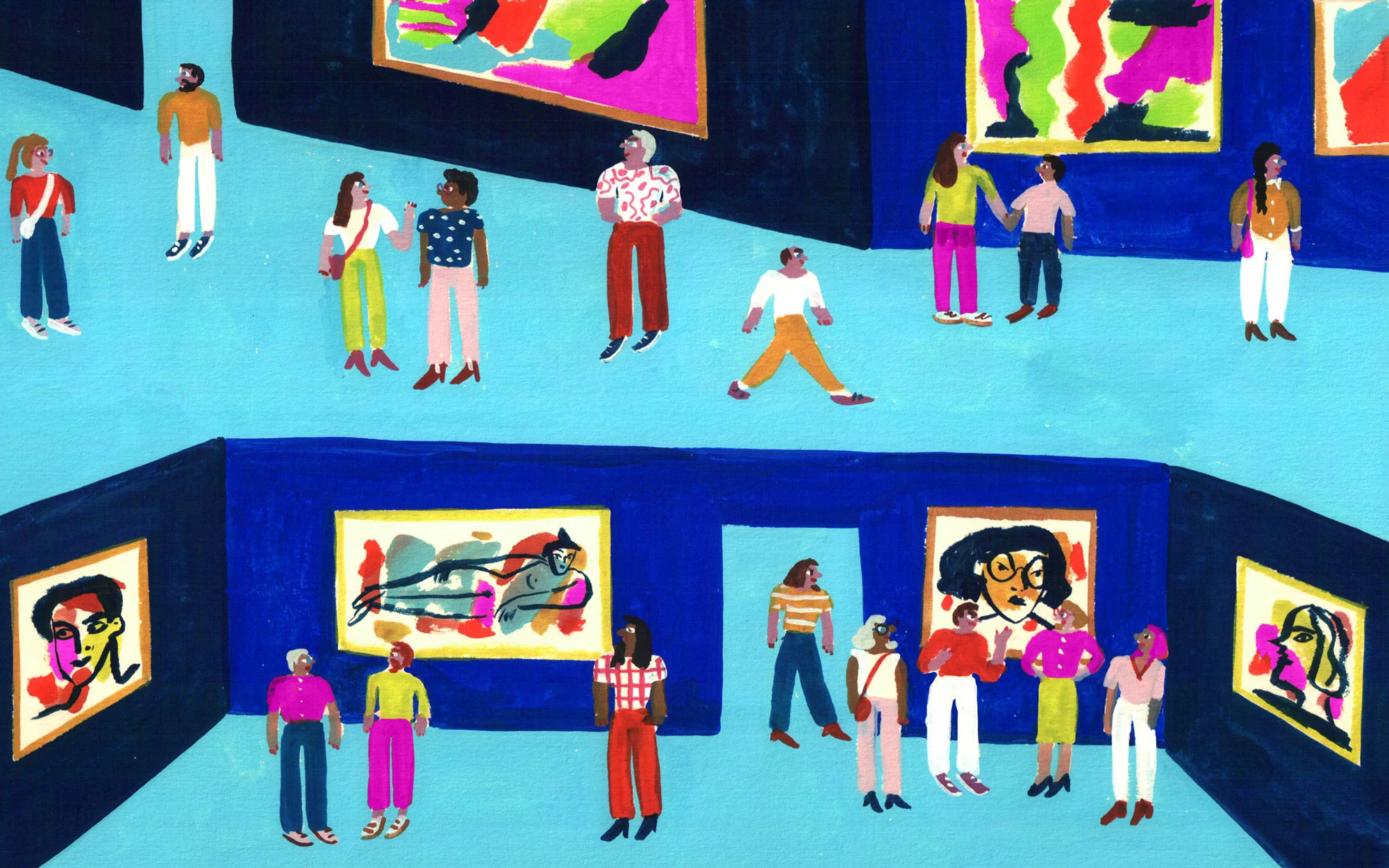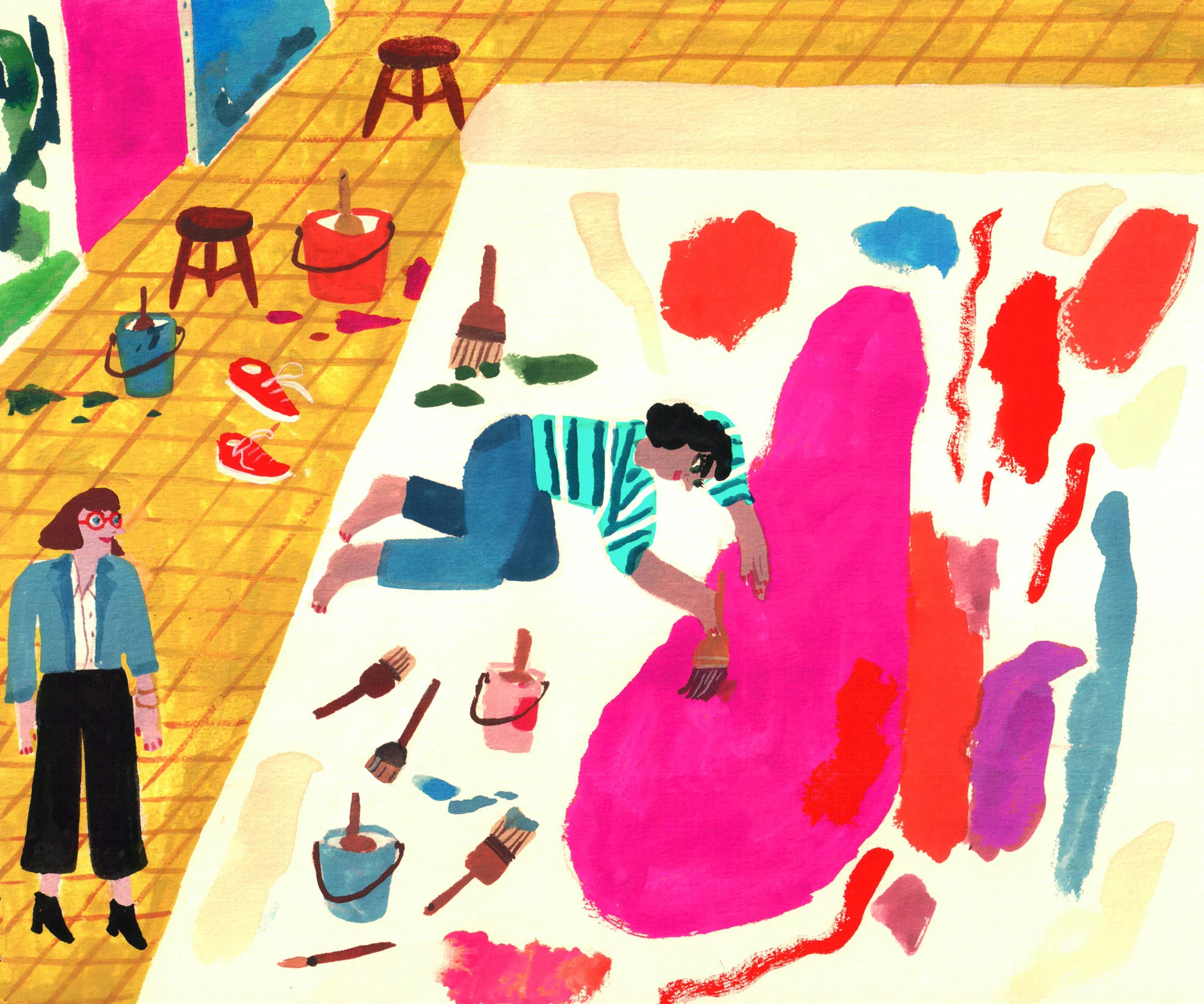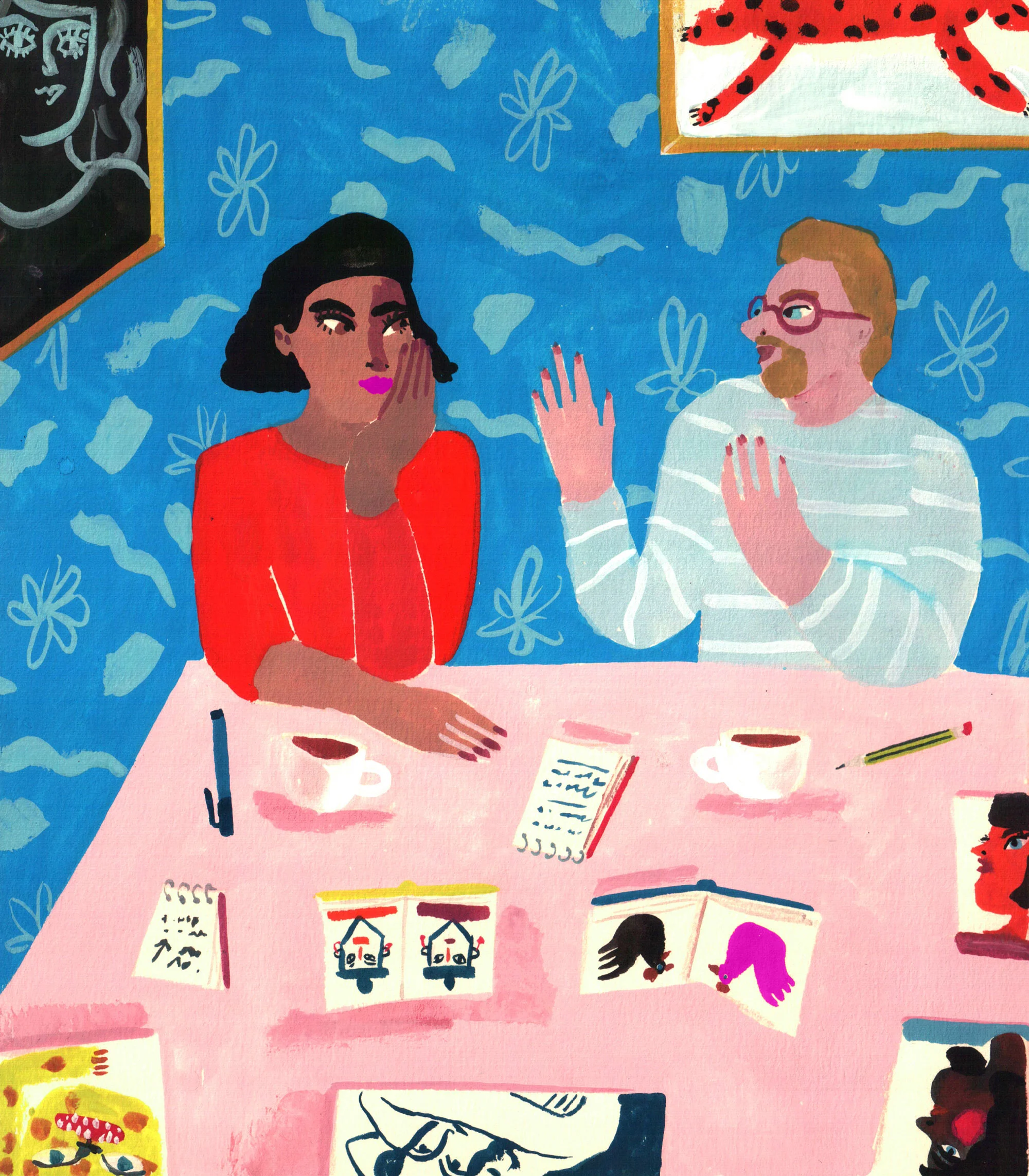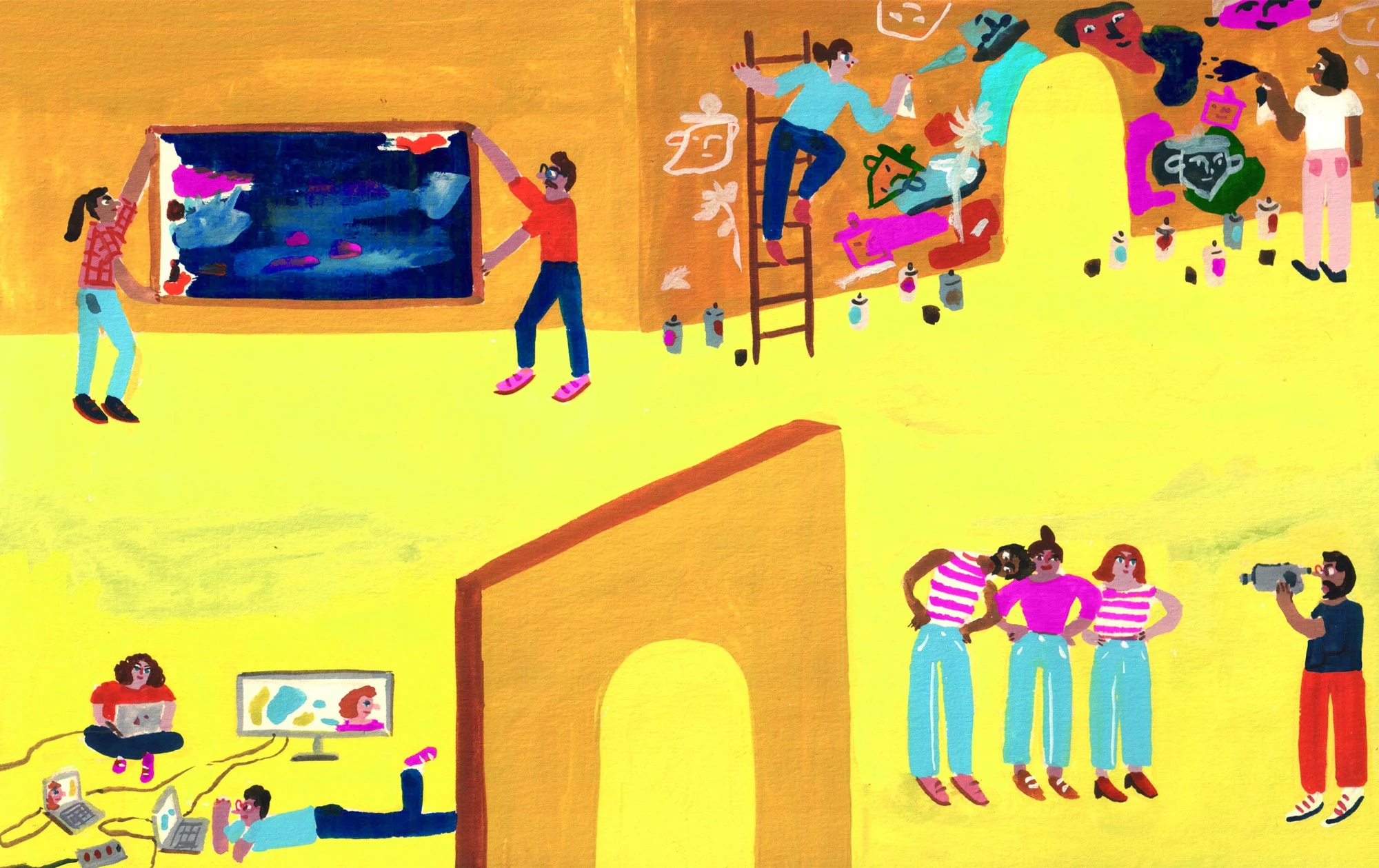

In an age where the word “curated” is bandied around somewhat, what is the true job of an artistic creator? What can their finely-honed skills bring to the art world or, more importantly, what effect can their relationship with artists have on the art itself? Art historian and writer Ferren Gipson meets some of the world’s leading curators to find out why what they do is so crucial to an artist’s creative process.
Illustrations by María Luque.
The idea of “curation” has increasingly infiltrated our daily lives in recent years. We curate our Instagram feeds, a local barista might curate a selection of roasts, and there was even a genuine article about whether “Curator boyfriends” were a summer trend a couple of years ago. But what is the role of a curator in an art context? The origin of the word comes from the Latin “curare,” which means “caretaker.” For a long time, curators largely worked for museums or collections as the keepers of artworks and objects. Over the course of the 20th century, their purview has expanded to incorporate elements of a critic, tastemaker, and, at times, a position almost akin to an artist.
When looking for curators to bring on board at the Smithsonian National Gallery, director Kim Sajet says her criteria has changed from what was expected in the past. “To me, I'm less interested in somebody who's bringing the objects, and more interested in the person who is bringing original ideas to the table,” says Kim. “I think in the past it really was this idea of a keeper, I think now it's more of someone who's a thought leader or coming up with new knowledge.”
Tandazani Dhlakama, an Assistant Curator at Zeitz MOCAA, recalls that her former colleague, Rafael Chikukwa, often said a curator is like a visual DJ. It’s a helpful analogy to understand the ways in which curators mix, organize, and present artworks to create new experiences and reflect fresh points-of-view. A key role of the curator is to ideate and facilitate exhibitions that encourage dialogue. This might include metaphorical conversations, such as visual dialogue between artworks in a show or between the themes of an exhibition and current events, or it can refer to the literal discourse among critics and attendees. Ideally, shows should connect to the concerns and interests of the communities in which they take place.
“What guides me is an artist or a moment or a medium that can be used to articulate something that I think is critical and urgent and relevant for today. Sometimes that requires looking back at history or reflecting on the past,” says Tandazani. “I'm less guided by the specific medium or style and more guided by the story – more guided by the narrative.”

Tandazani Dhlakama
What was the first exhibition you put on?
The first professional exhibition that I curated in an art institution was a group show titled Engaging with ‘the Other’ at the National Gallery of Zimbabwe. Prior to that, as a student, I had brought together different types of artists, poets and organisations for various causes, but at the time, the term “curating” wasn’t yet part of how I articulated the work I did.
What is one exhibition you have been to that really blew you away?
There are quite a few but if I had to choose just one that had an impact I would choose Kudzanai Chiurai’s exhibition We Need New Names, held at the National Gallery of Zimbabwe in November 2017 in Harare. The show was curated by Candice Allison and was Chiurai’s first solo exhibition in his home country. Many of us saw elements of our own underrepresented narratives articulated visually and sonically through this exhibition.
Who is another curator you really admire?
I have always admired Gabi Ngcobo. Apart from being an amazing curator who is able to present ideas in sensitive and thought-provoking ways, she is also a very generous human being.
If you could curate a show for any artist, living or dead, who would it be?
It is difficult to mention just one artist; my list is too long. There are quite a few women artists from the African continent who are doing incredible video and performance-based works that I am really keen to work with in the near future. I feel like their work hasn’t yet gotten the attention it deserves and I would love to collaborate with them.

Hans Ulrich Obrist
What was the first exhibition you put on?
My first show was World Soup, the show in my kitchen in St Gallen in 1991.
What is one exhibition you have been to that really blew you away?
Der Hang Zum Gesamtkunstwerk curated by Harald Szeemann in the mid 1980s. I visited the show as a teenageer 40 times.
Who is another curator you really admire?
A curator I admire is Lucy Lippard.
If you could curate a show for any artist living or dead, who would it be?
My unrealised exhibition is to do an exhibition with Jean Luc Godard.

It’s important to clarify that urgency shouldn’t be confused with reactivity. Most major exhibitions require years of planning, and curators, therefore, need to think critically about what stories need to be told far in advance of when shows actually take place. Curators can respond more immediately to current events through smaller shows or by creating content that shows how art and life intersect, but there’s a fine line where Tandazani says they must do this “without becoming a newsroom.”
As the Smithsonian National Portrait Gallery (NPG) is, both, an art and history museum, Kim Sajet says the institution is well placed to examine anthropological subjects through images. Anniversaries provide opportunities to revisit past events and reflect on their ongoing legacy. The NPG’s upcoming 2023 exhibition addressing the events of the year 1898 is an example of a show where curators have been planning for years in advance, yet the themes still hold immediate relevance to contemporary political issues. The exhibition will mark 125 years since the United States became an imperialist power through a series of events including overthrowing the queen in Hawaii, initiating the Spanish-American war, annexing Puerto Rico and Guam, and other campaigns. The reverberations of these events are still felt in issues like the United States’ volatile relationship with Cuba and ongoing discussions about Puerto Rico gaining statehood.
“Some of the proudest work I've done is where we've actually somehow intuited that it was important. This fall, we're doing an exhibition on Hung Liu, and we've been working on it for five years. She's a Chinese American artist, and she came to this country in the '70s,” says Kim. “It certainly has taken on a whole new urgency Asian xenophobia. And now, it feels like a really important moment to be having this conversation with this artist.”


Kim Sajet
What was the first exhibition you put on?
Arthur Boyd’s Lysistrata Series for the Mornington Peninsula Arts Center in Australia, 1989/90.
What is one exhibition you have been to that really blew you away?
Gerhard Richter: Forty Years of Painting, at MOMA in 2002.
Who is another curator you really admire?
Fred Wilson. He’s primarily an artist but his critique of museum practice and curatorial tropes has changed the field.
If you could curate a show for any artist living or dead, who would it be?
Rogier van der Weyden (dead) or Lava Thomas (living).
When the symbiotic relationship between curators and artists is at its strongest, the two parties can work together to create powerful shows. One way that curators can help artists bring their wildest ideas to life is by connecting them with other creative thinkers from a diversity of fields. A writer, for example, can help contextualize or expand the narrative around an artist’s work, or an engineer can assist with the technical aspects of creating a project. And this relationship works in both directions. When Hans had the idea for the previously mentioned “It’s Urgent” exhibition, he was able to call upon artists with whom he’s built a good relationship to bring his vision to life.
The art ecosystem is at its best when it is functioning as a supportive community. Artists realize this and are increasingly stepping into the roles of curator or mentor, themselves. Tandazani gives the example of Village Unhu in Harare, Zimbabwe, which is a space founded by three artists to support other creatives through workshops, residencies, exhibitions, and more. Exhibitions can be particularly exciting when curators start to think outside of the usual art conventions.
“I want people that can think in a cross-disciplinary way, and if I had a big criticism, I would say that curating in the art world has tended to maintain the silos within the art world in a way that is really artificial to life. Leonardo da Vinci was as much a scientist and a mathematician as he was an excellent draftsperson and artist,” says Kim. “I'm interested in curators who think about culture in a big picture way – more as anthropologists – and think about behavior. There is a point, too, where you need to be a specialist in your particular area, and getting that balance is a hard thing for a director because you can't have too many generalists. But I also want enough generalists that can say, ‘Yeah, we can talk about 9/11, or we're working on an exhibition of 1898 and the Spanish American War.’ I need both.”
There are more changes in the field to come as the world continues to shift around us. Emerging technologies and long-term issues like climate change are likely to impact the work of both artists and curators moving forward. “Artists are thinking more about how we can resist event culture and think about longer time horizons,” says Hans. “Every day, I think about what that means for curation? What does that mean for museums? For me, that’s the most interesting challenge right now.”

